stop start INFINITI Q50 2020 Workshop Manual
[x] Cancel search | Manufacturer: INFINITI, Model Year: 2020, Model line: Q50, Model: INFINITI Q50 2020Pages: 468, PDF Size: 2.18 MB
Page 346 of 468
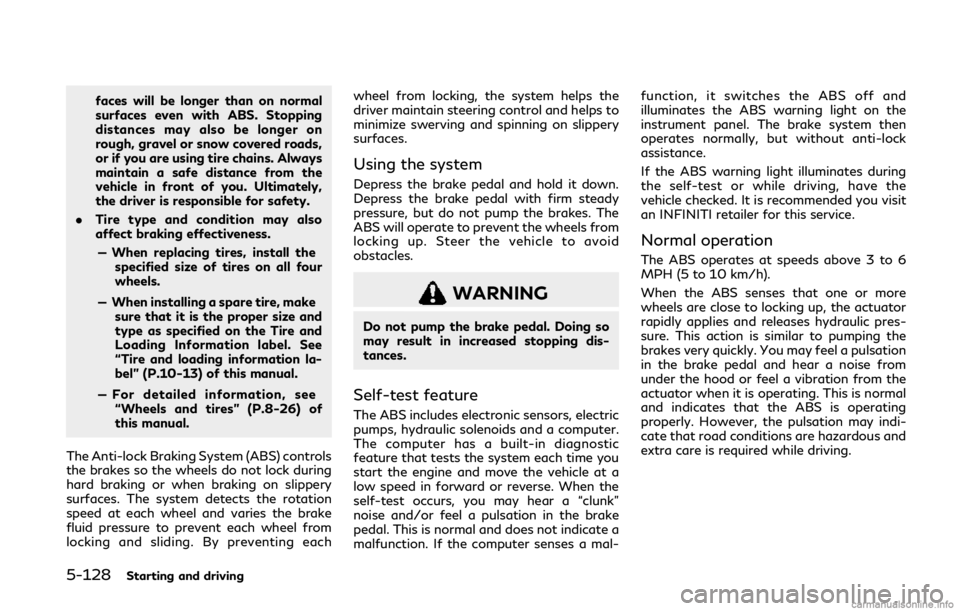
5-128Starting and driving
faces will be longer than on normal
surfaces even with ABS. Stopping
distances may also be longer on
rough, gravel or snow covered roads,
or if you are using tire chains. Always
maintain a safe distance from the
vehicle in front of you. Ultimately,
the driver is responsible for safety.
. Tire type and condition may also
affect braking effectiveness.
— When replacing tires, install the specified size of tires on all four
wheels.
— When installing a spare tire, make sure that it is the proper size and
type as specified on the Tire and
Loading Information label. See
“Tire and loading information la-
bel” (P.10-13) of this manual.
— For detailed information, see “Wheels and tires” (P.8-26) of
this manual.
The Anti-lock Braking System (ABS) controls
the brakes so the wheels do not lock during
hard braking or when braking on slippery
surfaces. The system detects the rotation
speed at each wheel and varies the brake
fluid pressure to prevent each wheel from
locking and sliding. By preventing each wheel from locking, the system helps the
driver maintain steering control and helps to
minimize swerving and spinning on slippery
surfaces.
Using the system
Depress the brake pedal and hold it down.
Depress the brake pedal with firm steady
pressure, but do not pump the brakes. The
ABS will operate to prevent the wheels from
locking up. Steer the vehicle to avoid
obstacles.
WARNING
Do not pump the brake pedal. Doing so
may result in increased stopping dis-
tances.
Self-test feature
The ABS includes electronic sensors, electric
pumps, hydraulic solenoids and a computer.
The computer has a built-in diagnostic
feature that tests the system each time you
start the engine and move the vehicle at a
low speed in forward or reverse. When the
self-test occurs, you may hear a “clunk”
noise and/or feel a pulsation in the brake
pedal. This is normal and does not indicate a
malfunction. If the computer senses a mal-function, it switches the ABS off and
illuminates the ABS warning light on the
instrument panel. The brake system then
operates normally, but without anti-lock
assistance.
If the ABS warning light illuminates during
the self-test or while driving, have the
vehicle checked. It is recommended you visit
an INFINITI retailer for this service.
Normal operation
The ABS operates at speeds above 3 to 6
MPH (5 to 10 km/h).
When the ABS senses that one or more
wheels are close to locking up, the actuator
rapidly applies and releases hydraulic pres-
sure. This action is similar to pumping the
brakes very quickly. You may feel a pulsation
in the brake pedal and hear a noise from
under the hood or feel a vibration from the
actuator when it is operating. This is normal
and indicates that the ABS is operating
properly. However, the pulsation may indi-
cate that road conditions are hazardous and
extra care is required while driving.
Page 350 of 468

5-132Starting and driving
WARNING
.Never rely solely on the hill start
assist system to prevent the vehicle
from moving backward on a hill.
Always drive carefully and atten-
tively. Depress the brake pedal when
the vehicle is stopped on a steep hill.
Be especially careful when stopped
on a hill on frozen or muddy roads.
Failure to prevent the vehicle from
rolling backwards may result in a loss
of control of the vehicle and possible
serious injury or death.
. The hill start assist system is not
designed to hold the vehicle at a
standstill on a hill. Depress the brake
pedal when the vehicle is stopped on
a steep hill. Failure to do so may
cause the vehicle to roll backwards
and may result in a collision or serious
personal injury.
. The hill start assist system may not
prevent the vehicle from rolling back-
wards on a hill under all load or road
conditions. Always be prepared to
depress the brake pedal to prevent
the vehicle from rolling backwards.
Failure to do so may result in a
collision or serious personal injury. The hill start assist system automatically
keeps the brakes applied to help prevent the
vehicle from rolling backwards in the time it
takes the driver to release the brake pedal
and apply the accelerator when the vehicle is
stopped on a hill.
The hill start assist system will operate
automatically under the following condi-
tions:
.
The transmission is shifted to a forward
or reverse gear.
. The vehicle is stopped completely on a hill
by applying the brake.
The maximum holding time is 2 seconds.
After 2 seconds the vehicle will begin to roll
back and the hill start assist system will stop
operating completely.
The hill start assist system will not operate
when the transmission is shifted to the N
(Neutral) or P (Park) position or on a flat and
level road. The chassis control is an electric control
module that includes the following func-
tions:
.
Log-in function (See “Log-in function”
(P.3-15).)
. INFINITI Drive Mode Selector (See
“INFINITI Drive Mode Selector” (P.5-
21).)
. Active Lane Control (if so equipped) (See
“Active Lane Control” (P.5-25).)
. Active Trace Control (See “Active trace
control” (P.5-130).)
HILL START ASSIST SYSTEM CHASSIS CONTROL
Page 352 of 468
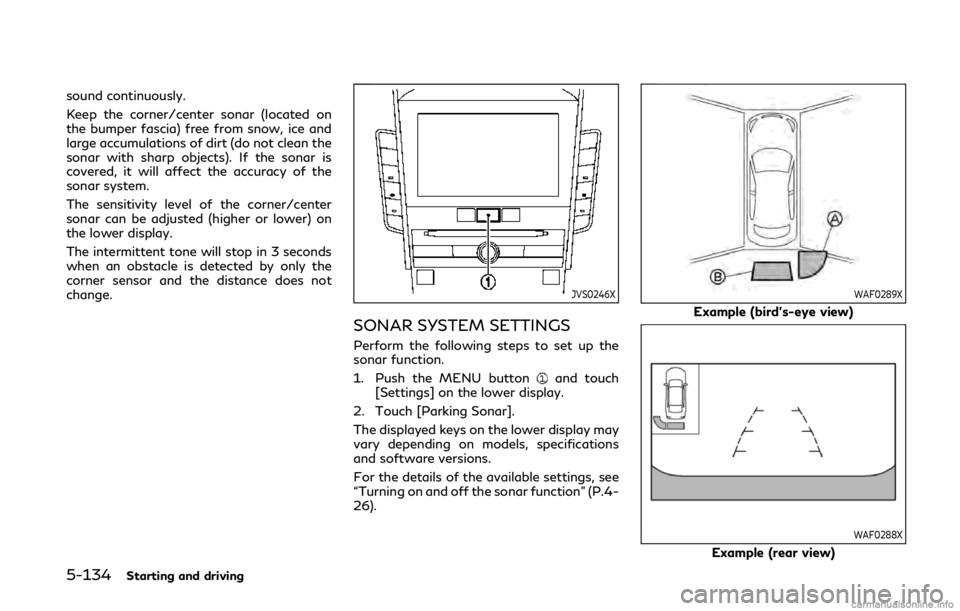
5-134Starting and driving
sound continuously.
Keep the corner/center sonar (located on
the bumper fascia) free from snow, ice and
large accumulations of dirt (do not clean the
sonar with sharp objects). If the sonar is
covered, it will affect the accuracy of the
sonar system.
The sensitivity level of the corner/center
sonar can be adjusted (higher or lower) on
the lower display.
The intermittent tone will stop in 3 seconds
when an obstacle is detected by only the
corner sensor and the distance does not
change.
JVS0246X
SONAR SYSTEM SETTINGS
Perform the following steps to set up the
sonar function.
1. Push the MENU button
and touch
[Settings] on the lower display.
2. Touch [Parking Sonar].
The displayed keys on the lower display may
vary depending on models, specifications
and software versions.
For the details of the available settings, see
“Turning on and off the sonar function” (P.4-
26).
WAF0289X
Example (bird’s-eye view)
WAF0288X
Example (rear view)
Page 354 of 468
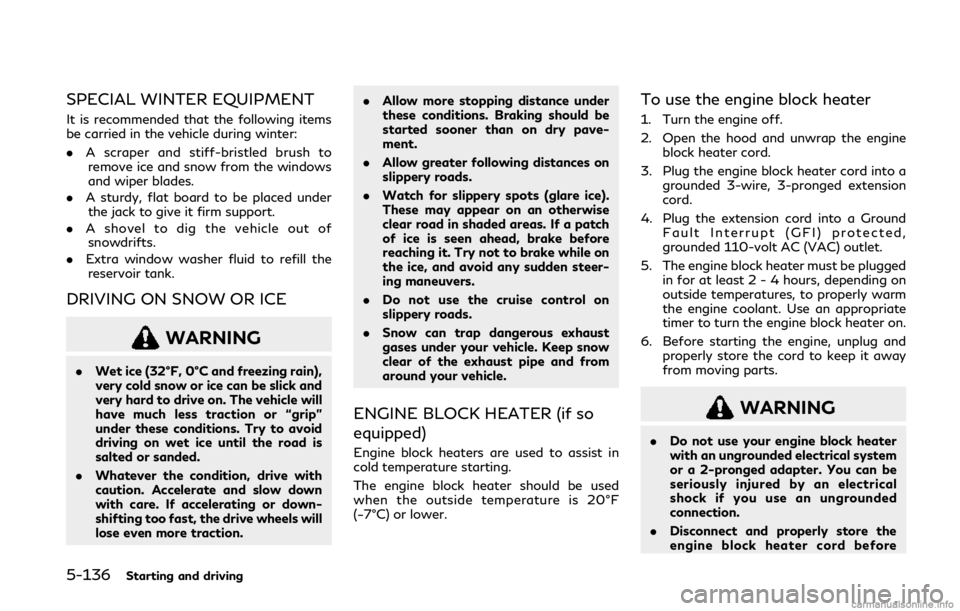
5-136Starting and driving
SPECIAL WINTER EQUIPMENT
It is recommended that the following items
be carried in the vehicle during winter:
.A scraper and stiff-bristled brush to
remove ice and snow from the windows
and wiper blades.
. A sturdy, flat board to be placed under
the jack to give it firm support.
. A shovel to dig the vehicle out of
snowdrifts.
. Extra window washer fluid to refill the
reservoir tank.
DRIVING ON SNOW OR ICE
WARNING
. Wet ice (32°F, 0°C and freezing rain),
very cold snow or ice can be slick and
very hard to drive on. The vehicle will
have much less traction or “grip”
under these conditions. Try to avoid
driving on wet ice until the road is
salted or sanded.
. Whatever the condition, drive with
caution. Accelerate and slow down
with care. If accelerating or down-
shifting too fast, the drive wheels will
lose even more traction. .
Allow more stopping distance under
these conditions. Braking should be
started sooner than on dry pave-
ment.
. Allow greater following distances on
slippery roads.
. Watch for slippery spots (glare ice).
These may appear on an otherwise
clear road in shaded areas. If a patch
of ice is seen ahead, brake before
reaching it. Try not to brake while on
the ice, and avoid any sudden steer-
ing maneuvers.
. Do not use the cruise control on
slippery roads.
. Snow can trap dangerous exhaust
gases under your vehicle. Keep snow
clear of the exhaust pipe and from
around your vehicle.
ENGINE BLOCK HEATER (if so
equipped)
Engine block heaters are used to assist in
cold temperature starting.
The engine block heater should be used
when the outside temperature is 20°F
(−7°C) or lower.
To use the engine block heater
1. Turn the engine off.
2. Open the hood and unwrap the engine
block heater cord.
3. Plug the engine block heater cord into a grounded 3-wire, 3-pronged extension
cord.
4. Plug the extension cord into a Ground Fault Interrupt (GFI) protected,
grounded 110-volt AC (VAC) outlet.
5. The engine block heater must be plugged in for at least 2 - 4 hours, depending on
outside temperatures, to properly warm
the engine coolant. Use an appropriate
timer to turn the engine block heater on.
6. Before starting the engine, unplug and properly store the cord to keep it away
from moving parts.
WARNING
.Do not use your engine block heater
with an ungrounded electrical system
or a 2-pronged adapter. You can be
seriously injured by an electrical
shock if you use an ungrounded
connection.
. Disconnect and properly store the
engine block heater cord before
Page 363 of 468
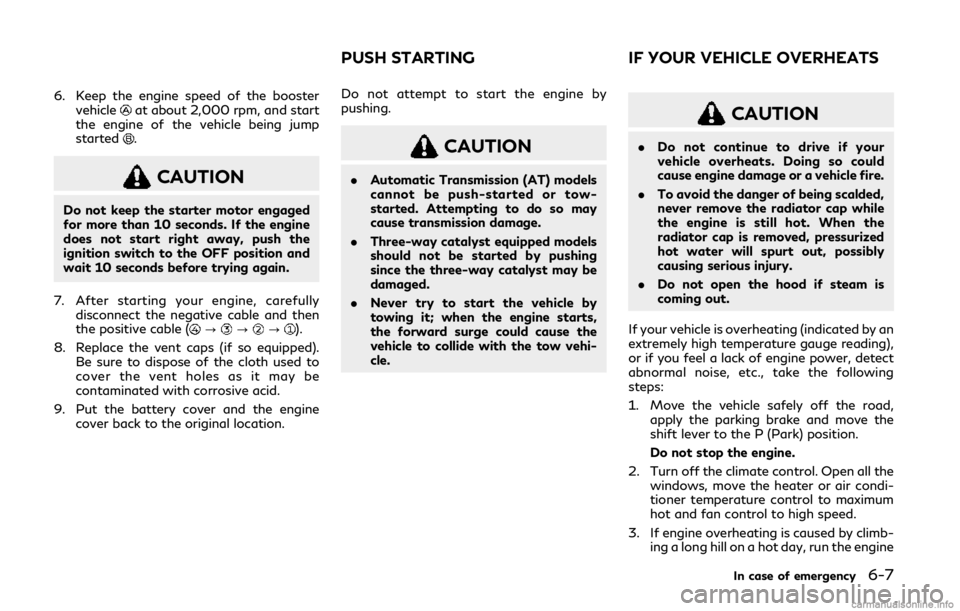
6. Keep the engine speed of the boostervehicleat about 2,000 rpm, and start
the engine of the vehicle being jump
started
.
CAUTION
Do not keep the starter motor engaged
for more than 10 seconds. If the engine
does not start right away, push the
ignition switch to the OFF position and
wait 10 seconds before trying again.
7. After starting your engine, carefully disconnect the negative cable and then
the positive cable (
???).
8. Replace the vent caps (if so equipped). Be sure to dispose of the cloth used to
cover the vent holes as it may be
contaminated with corrosive acid.
9. Put the battery cover and the engine cover back to the original location. Do not attempt to start the engine by
pushing.
CAUTION
.
Automatic Transmission (AT) models
cannot be push-started or tow-
started. Attempting to do so may
cause transmission damage.
. Three-way catalyst equipped models
should not be started by pushing
since the three-way catalyst may be
damaged.
. Never try to start the vehicle by
towing it; when the engine starts,
the forward surge could cause the
vehicle to collide with the tow vehi-
cle.
CAUTION
.Do not continue to drive if your
vehicle overheats. Doing so could
cause engine damage or a vehicle fire.
. To avoid the danger of being scalded,
never remove the radiator cap while
the engine is still hot. When the
radiator cap is removed, pressurized
hot water will spurt out, possibly
causing serious injury.
. Do not open the hood if steam is
coming out.
If your vehicle is overheating (indicated by an
extremely high temperature gauge reading),
or if you feel a lack of engine power, detect
abnormal noise, etc., take the following
steps:
1. Move the vehicle safely off the road, apply the parking brake and move the
shift lever to the P (Park) position.
Do not stop the engine.
2. Turn off the climate control. Open all the windows, move the heater or air condi-
tioner temperature control to maximum
hot and fan control to high speed.
3. If engine overheating is caused by climb- ing a long hill on a hot day, run the engine
In case of emergency6-7
PUSH STARTING IF YOUR VEHICLE OVERHEATS
Page 364 of 468
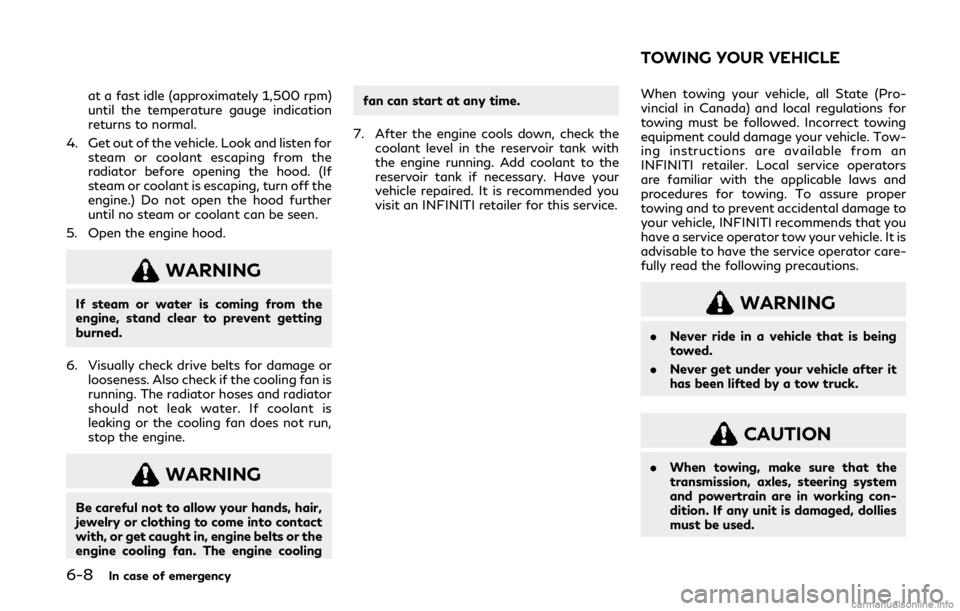
6-8In case of emergency
at a fast idle (approximately 1,500 rpm)
until the temperature gauge indication
returns to normal.
4. Get out of the vehicle. Look and listen for steam or coolant escaping from the
radiator before opening the hood. (If
steam or coolant is escaping, turn off the
engine.) Do not open the hood further
until no steam or coolant can be seen.
5. Open the engine hood.
WARNING
If steam or water is coming from the
engine, stand clear to prevent getting
burned.
6. Visually check drive belts for damage or looseness. Also check if the cooling fan is
running. The radiator hoses and radiator
should not leak water. If coolant is
leaking or the cooling fan does not run,
stop the engine.
WARNING
Be careful not to allow your hands, hair,
jewelry or clothing to come into contact
with, or get caught in, engine belts or the
engine cooling fan. The engine cooling fan can start at any time.
7. After the engine cools down, check the coolant level in the reservoir tank with
the engine running. Add coolant to the
reservoir tank if necessary. Have your
vehicle repaired. It is recommended you
visit an INFINITI retailer for this service. When towing your vehicle, all State (Pro-
vincial in Canada) and local regulations for
towing must be followed. Incorrect towing
equipment could damage your vehicle. Tow-
ing instructions are available from an
INFINITI retailer. Local service operators
are familiar with the applicable laws and
procedures for towing. To assure proper
towing and to prevent accidental damage to
your vehicle, INFINITI recommends that you
have a service operator tow your vehicle. It is
advisable to have the service operator care-
fully read the following precautions.
WARNING
.
Never ride in a vehicle that is being
towed.
. Never get under your vehicle after it
has been lifted by a tow truck.
CAUTION
.When towing, make sure that the
transmission, axles, steering system
and powertrain are in working con-
dition. If any unit is damaged, dollies
must be used.
TOWING YOUR VEHICLE
Page 391 of 468

WARNING
.Operating the engine with the air
cleaner removed can cause you or
others to be burned. The air cleaner
not only cleans the air, it stops flame
if the engine backfires. If it isn’t
there, and the engine backfires, you
could be burned. Do not drive with
the air cleaner removed, and be care-
ful when working on the engine with
the air cleaner removed.
. Never pour fuel into the throttle body
or attempt to start the engine with
the air cleaner removed. Doing so
could result in serious injury.
The filter element should not be cleaned and
reused. Replace it according to the main-
tenance schedule shown in the “9. Main-
tenance and schedules” section. When
replacing the filter, wipe the inside of the
air cleaner housing and the cover with a
damp cloth.
When maintenance is required, it is recom-
mended you contact an INFINITI retailer for
servicing.
CLEANING
If your windshield is not clear after using the
windshield washer or if a wiper blade
chatters when running, wax or other materi-
al may be on the blade or windshield.
Clean the outside of the windshield with a
washer solution or a mild detergent. Your
windshield is clean if beads do not form
when rinsing with clear water.
Clean each blade by wiping it with a cloth
soaked in a washer solution or a mild
detergent. Then rinse the blade with clear
water. If your windshield is still not clear
after cleaning the blades and using the
wiper, replace the blades.
Worn windshield wiper blades can damage
the windshield and impair driver vision.
When a washer nozzle is clogged
It is recommended you see an INFINITI
retailer if a washer nozzle is clogged or any
malfunction occurs. Do not attempt to clean
the nozzle using a needle or a pin. Doing so
may damage the nozzle.
Do-it-yourself8-15
AIR CLEANER WINDSHIELD WIPER BLADES
Page 457 of 468

11 Index
A
ABS (Anti-lock Braking System) ................... 5-127
Active Lane Control ............................................ 5-25
Active noise cancellation ................................. 5-138
Active sound enhancement ............................ 5-138
Active trace control ......................................... 5-130
Air bag systemFront-seat mounted side-impact
supplemental air bag system ..................... 1-55
Roof-mounted curtain side-impact
supplemental air bag system ..................... 1-55
Air bag warning labels ....................................... 1-58
Air bag warning light .............................. 1-58, 2-15
Air cleaner housing filter ................................... 8-15
Air conditioner
Air conditioner operation ............................ 4-36
Air conditioner service ................................ 4-42
Air conditioner specification label ......... 10-13
Air conditioning system refrigerant
and lubricant recommendations .... 4-42, 10-7
Automatic air conditioner ........................... 4-37
DUAL mode setting ..................................... 4-40
Heater and air conditioner .......................... 4-36
Servicing air conditioner ............................. 4-42
Air deflectors ...................................................... 10-15
Alarm How to stop alarm (see vehicle
security system) ............................................ 2-30
Alcohol, drugs and driving ................................ 5-10 Antenna .................................................................. 4-43
Anti-lock Braking System (ABS) ................... 5-127
Appearance care
Exterior appearance care ............................... 7-2
Interior appearance care ................................ 7-5
Armrest ...................................................................... 1-7
Around View
®Monitor ...................................... 4-11
Audible reminders ................................................. 2-17
Autolight system .................................................. 2-35
Automatic Automatic air conditioner ........................... 4-37
Automatic Transmission Fluid (ATF) ......... 8-9
Driving with automatic transmission ....... 5-16
Automatic door locks ............................................ 3-5
Automatic drive positioner ............................... 3-32
Automatic seat positioner ................................ 3-32
Avoiding collision and rollover ............................ 5-9
B
Back-up Collision Intervention (BCI) .............. 5-61
Battery .................................................................... 8-11
Battery replacement, Intelligent Key ......... 3-2
Battery saver system .................................... 2-38
Intelligent Key ................................................. 8-19
Variable voltage control system ............... 8-13
Before starting the engine ................................ 5-14
Belts (See drive belts) ......................................... 8-13
Blind Spot Intervention
®(BSI) ......................... 5-48
Blind Spot Warning (BSW) .............................. 5-40 Brake
Anti-lock Braking System (ABS) ............. 5-127
Brake fluid ...................................................... 8-10
Brake force distribution ............................. 5-129
Brake system ................................................ 5-126
Parking brake operation ............................. 5-20
Brake warning light .............................................. 2-11
Break-in schedule .............................................. 5-119
Bulb check/instrument panel ........................... 2-10
Bulb replacement ................................................. 8-22
C
Camera aiding sonar function ......................... 4-25
Capacities and
recommended fluids/lubricants ....................... 10-2
Car phone or CB radio ....................................... 4-43
Card holder ............................................................ 2-48
Catalytic converter Three-way catalyst ......................................... 5-5
Changing intercooler coolant ............................. 8-6
Chassis control ................................................... 5-132
Check tire pressure warning ............................. 2-21
Checking intercooler coolant level .................... 8-6
Child restraints ...................................................... 1-21 LATCH system ............................................... 1-23
Precautions on child restraints .................. 1-21
Child safety ............................................................ 1-19
Child safety rear door lock .................................. 3-6